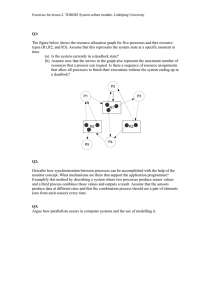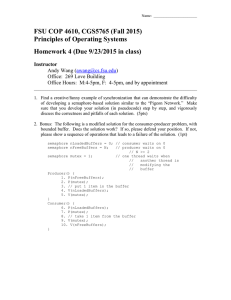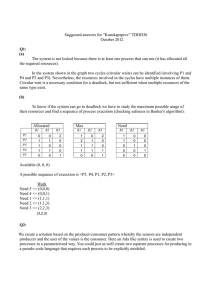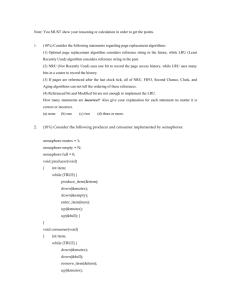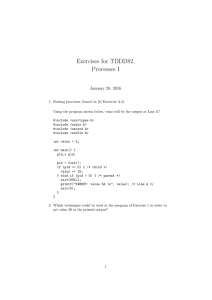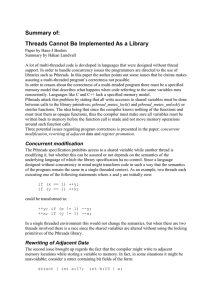Long-Distance Mutual Exclusion for Propositional Planning
advertisement
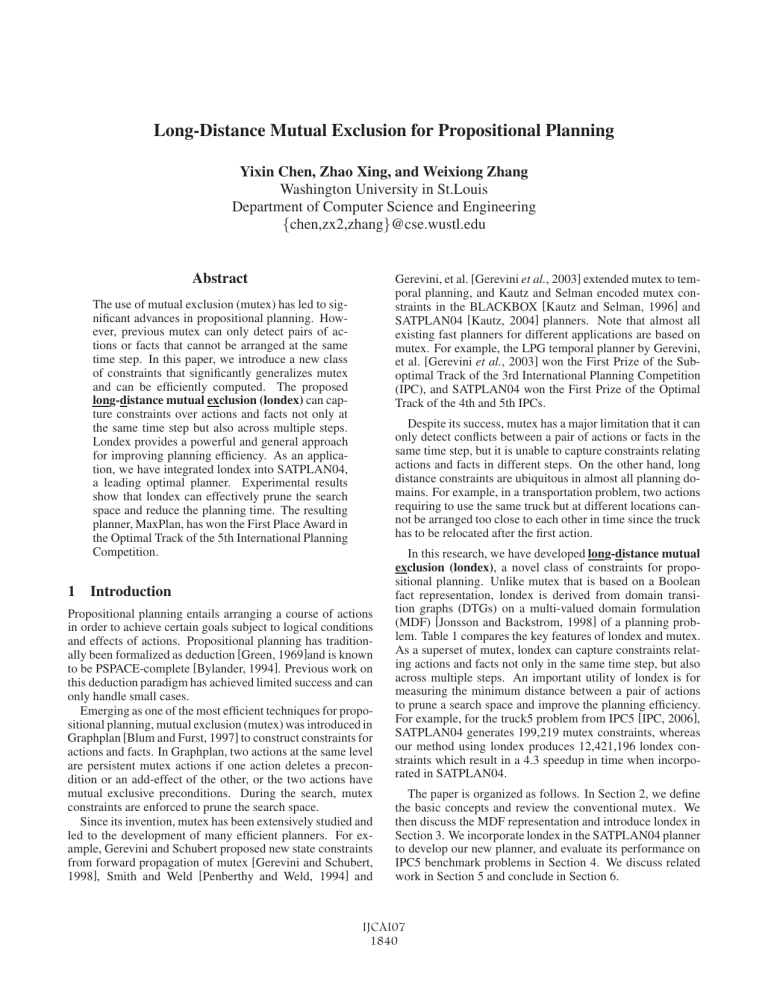
Long-Distance Mutual Exclusion for Propositional Planning
Yixin Chen, Zhao Xing, and Weixiong Zhang
Washington University in St.Louis
Department of Computer Science and Engineering
{chen,zx2,zhang}@cse.wustl.edu
Abstract
Gerevini, et al. [Gerevini et al., 2003] extended mutex to temporal planning, and Kautz and Selman encoded mutex constraints in the BLACKBOX [Kautz and Selman, 1996] and
SATPLAN04 [Kautz, 2004] planners. Note that almost all
existing fast planners for different applications are based on
mutex. For example, the LPG temporal planner by Gerevini,
et al. [Gerevini et al., 2003] won the First Prize of the Suboptimal Track of the 3rd International Planning Competition
(IPC), and SATPLAN04 won the First Prize of the Optimal
Track of the 4th and 5th IPCs.
The use of mutual exclusion (mutex) has led to significant advances in propositional planning. However, previous mutex can only detect pairs of actions or facts that cannot be arranged at the same
time step. In this paper, we introduce a new class
of constraints that significantly generalizes mutex
and can be efficiently computed. The proposed
long-distance mutual exclusion (londex) can capture constraints over actions and facts not only at
the same time step but also across multiple steps.
Londex provides a powerful and general approach
for improving planning efficiency. As an application, we have integrated londex into SATPLAN04,
a leading optimal planner. Experimental results
show that londex can effectively prune the search
space and reduce the planning time. The resulting
planner, MaxPlan, has won the First Place Award in
the Optimal Track of the 5th International Planning
Competition.
Despite its success, mutex has a major limitation that it can
only detect conflicts between a pair of actions or facts in the
same time step, but it is unable to capture constraints relating
actions and facts in different steps. On the other hand, long
distance constraints are ubiquitous in almost all planning domains. For example, in a transportation problem, two actions
requiring to use the same truck but at different locations cannot be arranged too close to each other in time since the truck
has to be relocated after the first action.
1 Introduction
Propositional planning entails arranging a course of actions
in order to achieve certain goals subject to logical conditions
and effects of actions. Propositional planning has traditionally been formalized as deduction [Green, 1969]and is known
to be PSPACE-complete [Bylander, 1994]. Previous work on
this deduction paradigm has achieved limited success and can
only handle small cases.
Emerging as one of the most efficient techniques for propositional planning, mutual exclusion (mutex) was introduced in
Graphplan [Blum and Furst, 1997] to construct constraints for
actions and facts. In Graphplan, two actions at the same level
are persistent mutex actions if one action deletes a precondition or an add-effect of the other, or the two actions have
mutual exclusive preconditions. During the search, mutex
constraints are enforced to prune the search space.
Since its invention, mutex has been extensively studied and
led to the development of many efficient planners. For example, Gerevini and Schubert proposed new state constraints
from forward propagation of mutex [Gerevini and Schubert,
1998], Smith and Weld [Penberthy and Weld, 1994] and
In this research, we have developed long-distance mutual
exclusion (londex), a novel class of constraints for propositional planning. Unlike mutex that is based on a Boolean
fact representation, londex is derived from domain transition graphs (DTGs) on a multi-valued domain formulation
(MDF) [Jonsson and Backstrom, 1998] of a planning problem. Table 1 compares the key features of londex and mutex.
As a superset of mutex, londex can capture constraints relating actions and facts not only in the same time step, but also
across multiple steps. An important utility of londex is for
measuring the minimum distance between a pair of actions
to prune a search space and improve the planning efficiency.
For example, for the truck5 problem from IPC5 [IPC, 2006],
SATPLAN04 generates 199,219 mutex constraints, whereas
our method using londex produces 12,421,196 londex constraints which result in a 4.3 speedup in time when incorporated in SATPLAN04.
The paper is organized as follows. In Section 2, we define
the basic concepts and review the conventional mutex. We
then discuss the MDF representation and introduce londex in
Section 3. We incorporate londex in the SATPLAN04 planner
to develop our new planner, and evaluate its performance on
IPC5 benchmark problems in Section 4. We discuss related
work in Section 5 and conclude in Section 6.
IJCAI07
1840
Property
representation
generation time
relevant level(s)
fact constraints
action constraints
quantity
pruning
relationship
Mutex
Londex
Boolean facts
MDF
polynomial
polynomial
same level
multiple levels
from actions
from DTG analysis
from add/del/pre facts from fact distances
moderate
large
moderate
strong
persistent mutex ⊂ londex
2 Propositional Planning and Mutex
Propositional planning requires to generate a sequence of actions in order to accomplish a set of goals. Propositional
planning can be described in the STRIPS formalism, which
is represented by a set of Boolean facts. Given a set of facts
F = {f1 , f2 , · · · , fn }, a state s is a subset of F where every
fact in s is True.
Example 1. A simple cargo planning problem concerns moving a piece of cargo C among three locations L1, L2 and
L3 using a truck T . The fact set F includes all the facts
about possible locations of the truck and the cargo, such as
at(T, L1), at(C, L2), and in(C, T ). A state specifies the current status. For example, s = {at(T, L1), at(C, L3)}.
Definition 1 An action o is a triplet o
=
(pre(o), add(o), del(o)), where pre(o) ⊆ F is the set of
preconditions of action o, and add(o) ⊆ F and del(o) ⊆ F
are the sets of add facts and delete facts, respectively.
The result of applying an action o to a state s is defined as:
j
s ∪ add(o) \ del(o),
undef ined,
3 Long-Distance Mutual Exclusion (Londex)
To develop londex, we first consider the multi-valued formulation of propositional planning.
3.1
Table 1: Comparison of persistent mutex and londex.
Result(s, o) =
As a result, many fast planners only use persistent mutex constraints. In the rest of the paper, when we mention mutex, we
refer to persistent mutex.
if pre(o) ⊆ s;
otherwise.
Consequently,
applying a sequence of actions
P
= o1 , o2 , · · · , on results in Result(s, P ) =
AlterResult(· · · (Result(Result(s, o1), o2 )) · · · on ).
natively, a set of actions can be performed in a parallel plan
with a number of time steps, where multiple actions can be
executed in a time step.
Definition 2 A planning task is a triplet T = (O, I, G),
where O is a set of actions, I ⊆ F is the initial state, and
G ⊆ F is the goal specification.
Definition 3 Persistent mutex of actions. Actions o1 and
o2 are mutex when any of the following sets is not empty:
pre(o1 ) ∩ del(o2 ), pre(o2 ) ∩ del(o1 ), del(o1 ) ∩ add(o2 ), and
del(o2 )∩add(o1 ), or when there exist two facts f1 ∈ pre(o1 )
and f2 ∈ pre(o2 ) that are mutex.
Definition 4 Persistent mutex of facts. Two facts f1 and f2
are mutex if there do not exist two non-mutex actions o1 and
o2 such that f1 ∈ add(o1 ) and f2 ∈ add(o2 ).
The mutex constraints defined above [Blum and Furst,
1997; Gerevini et al., 2003] are persistent in the sense that
they are always effective, regardless of the initial state or
the level of a planning graph. Blum and Furst [Blum and
Furst, 1997] also suggested to derive non-persistent mutex
dependent of initial states and levels. However, deriving
non-persistent mutex usually requires to construct a planning
graph, which is expensive and impractical for large problems.
Domain Transition Graph
The multi-valued domain formulation (MDF) [Jonsson and
Backstrom, 1998] translates Boolean facts into a more compact representation using multi-valued variables, where each
variable represents a group of Boolean facts in which only
one of them can be true in any state.
The MDF representation of a propositional planning domain is defined over a set of multi-valued variables: X =
(x1 , x2 , · · · , xm ), where xi has a finite discrete domain Di .
For a planning problem, the value assignment of a multivalued variable in MDF corresponds to a Boolean fact. Given
an MDF variable assignment x = v and a Boolean fact f , we
can denote this correspondence as f = MDF(x, v).
An MDF state s is encoded as a complete assignment of all
the variables in X: s = (x1 = v1 , x2 = v2 , · · · , xm = vm ),
where xi is assigned a value vi ∈ Di , for i = 1, 2, . . . , m.
Example 3. To formulate Example 1 in MDF, we use two
MDF variables, LocationT and LocationC ,to denote the locations of the truck and the cargo, respectively. LocationT
can take values from DT = {L1, L2, L3} and LocationC
from DC = {L1, L2, L3, T }. An example state is s =
(LocationT = L1, LocationC = T ).
For every multi-valued variable in MDF, there is a corresponding domain transition graph defined as follows.
Definition 5 (Domain transition graph (DTG)). Given an
MDF variable x ∈ X with domain Dx , its DTG Gx is a
digraph with vertex set Dx and arc set Ax . There is an arc
(v, v ) ∈ Ax iff there is an action o with del(o) = v and
add(o) = v , in which case the arc (v, v ) is labeled by o and
we say there is a transition from v to v by action o.
Definition 6 (Fact distance in a DTG). Given a DTG Gx ,
the distance from a fact f1 = MDF(x, v1 ) to another factor
f2 = MDF(x, v2 ), written as ΔGx (f1 , f2 ), is defined as the
minimum distance from vertex v1 to vertex v2 in Gx .
Example 4. In the cargo example, the cargo can be
loaded into the truck or unloaded at a location, and the
truck can move among different locations. The DTGs of
the cargo and truck are shown in Figure 1. In the figure, ΔGLocationC (MDF(C, L1), MDF(C, L2)) = 2, and
ΔGLocationT (MDF(T, L3), MDF(T, L1)) = ∞.
Following a method used in the Fast Downward planner [Helmert, 2006], we have implemented our own preprocessing engine to generate DTGs. The main steps of the
preprocessing include detecting invariant fact groups, finding MDF variables, and generating the value transitions for
each MDF variable. Details of the algorithm can be found in
Helmert’s paper [Helmert, 2006].
IJCAI07
1841
1. procedure Generate Londex (P )
(INPUT: A STRIPS planning problem P )
(OUTPUT: londex constraints for facts and actions)
2.
generate the DTGs for P ;
3.
generate fact londex based on the DTGs;
4.
for each fact f do
5.
generate action londex in EA1(f );
6.
for each DTG graph Gx do
7.
for each pair of facts (f1 , f2 ), f1 , f2 ∈ Gx do
8.
generate action londex in EA2(f1 , f2 );
9. end procedure
AT location1
AT location1
Cargo1
Truck1
LOAD/UNLOAD
MOVE
AT location2
IN truck1
LOAD/UNLOAD
LOAD/UNLOAD
AT location2
AT location3
MOVE
AT location3
Figure 1: DTGs for MDF variables LocationC and LocationT in
Example 4.
3.2
Generation of Londex Constraints
We now define londex based on the MDF representation. We
define t(f ) as the time step at which the fact f is valid, and
t(o) as the time step at which an action o is chosen.
Londex constraints for facts. Given two Boolean facts f1
and f2 , if f1 and f2 correspond to two nodes in a DTG Gx
and ΔGX (f1 , f2 ) = r, then there is no valid plan in which
0 ≤ t(f2 ) − t(f1 ) < r.
Example 5. Continuing from Example 4, if at(C, L1) is true
at time step 0, then at(C, L2) cannot be true before step 2.
Londex constraints for actions. For simplicity, we say
that an action o is associated with a fact f if f appears in
pre(o), add(o), or del(o). Given two actions a and b, we
consider two classes of londex constraints between them.
Class A. If a and b are associated with a fact f , a and b are
mutually exclusive if one of the following holds.
1) f ∈ add(a), f ∈ del(b), and t(a) = t(b);
2) f ∈ del(a), f ∈ pre(b), and 0 ≤ t(b) − t(a) ≤ 1;
Note that A(1) and A(2) are stronger than the original mutex due to the inequalities in A(2). If we replace the inequalities in A(2) by t(a) = t(b), A(1) - A(2) are equivalent to the
original mutex.
Class B. If a is associated with fact f1 , b is associated with
fact f2 , and it is invalid to have 0 ≤ t(f2 ) − t(f1 ) < r according to fact londex, then a and b are mutually exclusive if
one of the following holds.
1) f1 ∈ add(a), f2 ∈ add(b), and 0 ≤ t(b) − t(a) ≤ r − 1;
2) f1 ∈ add(a), f2 ∈ pre(b), and 0 ≤ t(b) − t(a) ≤ r;
3) f1 ∈ pre(a), f2 ∈ add(b), and 0 ≤ t(b) − t(a) ≤ r − 2;
4) f1 ∈ pre(a), f2 ∈ pre(b), and 0 ≤ t(b) − t(a) ≤ r − 1.
Intuitively, since two facts f1 and f2 in the same DTG cannot appear too closely due to the structure of the DTG, two
actions associated with these facts should also keep a minimum distance. For example, in case B(2), if a is executed at
time t(a), then f1 is valid at time t(a) + 1. Since the fact
distance from f1 to f2 is larger than r, f2 (the precondition
of b) cannot be true until time t(a) + 1 + r, which means b
cannot be true until time t(a) + 1 + r. Other cases can be
proved similarly.
The procedure to generate the londex constraints is in Table 2, in which EA1(f ) represents all Class-A action londex
related to a fact f , and EA2(f1 , f2 ) denotes all Class-B action londex related to a pair of facts f1 and f2 in a DTG.
Example 6. In the cargo example, mutex can only detect the constraints that the truck cannot arrive at and
leave the same location at the same time. For example,
move(T, L1, L2) and move(T, L3, L1) are mutually exclusive because move(T, L1, L2) deletes at(T, L1) while
Table 2: Generation of londex constraints.
move(T, L3, L1) adds at(T, L1). In contrast, londex is
stronger as it specifies that two actions using the same truck,
even if they happen at different time, may lead to a conflict. For example, if L1 and L4 are 5 steps apart in a DTG,
then the conflict of arranging move(T, L1, L2) at step 0 and
move(T, L4, L3) at step 3 is a londex but not a mutex.
3.3
Analysis of Londex Constraints
In this section, we study the completeness, computation complexity, and pruning power of londex constraints.
Proposition 1 For any planning problem P , the set of persistent mutex is a subset of londex.
This is true by the definitions of mutex and londex. The
Class A action londex include all persistent action mutex.
Proposition 2 Londex constraints can be generated in time
polynomial in the number of facts.
Proof. Due to space limits, we only sketch the time results
here. We denote the number of facts as |F | and the plan length
as T . We use S to denote the upper bound of the number
of preconditions, add effects, or delete effects that any action may have in a planning domain. Usually S is a small
constant for most planning domains. The time to generate
the DTGs is O(S|F |2 ). The time to generate Class A londex is O(T S 2 |F |), and the time to generate Class B londex
is O(T S 2 |F |2 ). Therefore, the total time complexity for the
algorithm is O(T S 2 |F |2 ), which is polynomial in |F |.
Proposition 2 gives the worst case complexity guarantee to generate all londex constraints. This is comparable
to the polynomial time complexity to generate mutex constraints [Blum and Furst, 1997]. Empirically, our preprocessor takes less than 30 seconds to generate all londex constraints for each of the problems in IPC5, which is negligible
comparing to the planning time that londex can help reduce,
often in thousands of seconds for large problems.
Table 3 illustrates the use of londex in reducing planning
time. We can compare the size of mutex constraints derived
by Blackbox and SATPLAN04 (two SAT-based planners using mutex) and the londex constraints. The amount of londex
constraints is 2 to 100 times larger than that of mutex, depending on planning domains. It is evident from Table 3 that
incorporating londex in a SAT planner, although largely increases the size of the SAT instance, can significantly reduce
the speed of SAT solving because of the much stronger constraint propagation and pruning.
IJCAI07
1842
method
SATPLAN04
Blackbox
SATPLAN04+londex
size
2.90e5
2.87e5
1.96e7
U. P.
3.51e7
4.06e7
3.13e7
decisions
83398
496254
22015
time
109.5
267.8
34.5
Domains
openstacks
TPP
truck
storage
pathways
pipeworld
rovers
Table 3: Comparison of the number of constraints, unit propagations (UP), decisions, and solution time of SATPLAN04,
Blackbox, and SATPLAN04 with londex, for solving the
truck3 problem from IPC5 at time step 15.
1. procedure SATPLAN04+londex
(INPUT: A propositional planning problem P )
2.
generate the DTGs and londex constraints for P ;
3.
set k to be an lower bound of the optimal plan length;
4.
repeat
5.
convert P to a planning graph with k time steps;
6.
translate the planning graph into a SAT instance;
7.
add the londex constraints to the SAT;
8.
solve the SAT instance by a generic SAT solver;
9.
if (the SAT instance is satisfiable)
10.
convert the SAT solution to a propositional plan;
11.
else increase plan length by one, k ←− k + 1;
12.
until a solution is found.
13. end procedure
Table 4: The framework of SATPLAN04+londex.
4 Experimental Results
As an application of londex, we incorporated londex constraints in SATPLAN04 [Kautz, 2004], a leading SAT-based
optimal propositional planner which attempts to minimize
the number of time steps. SATPLAN04 converts a planning
problem to a Boolean satisfiability (SAT) problem and solves
it using a SAT solver. SATPLAN04 uses an action-based
encoding that converts all fact variables to action variables.
Besides some goal constraints and action-precondition constraints, most of the constraints in the SAT are binary constraints modeling the mutex between actions.
We replaced the mutex constraints with londex constraints,
and kept other components of SATPLAN04 unchanged. Following the action-based encoding of SATPLAN04, we used a
Boolean variable vi,j to represent the execution of an action
oi in time step j. If an action oi1 in time step j1 and an action
oi2 in time step j2 were mutually exclusive due to a londex
constraint, the clause ¬vi1 ,j1 ∨ ¬vi2 ,j2 was generated.
The resulting algorithm SATPLAN04+londex is shown in
Table 4. Starting from a lower bound k of the optimal plan
length, SATPLAN04+londex iteratively solves, for each targeted plan length k, a converted SAT problem augmented by
londex constraints. The method increases k until the optimal
plan length is reached. We only need to generate all londex
constraints once and save them for use by all steps.
The current default SAT solver in SATPLAN04 is
Siege [Ryan, 2003]. In our experiments, we found that running Siege in SATPLAN04+londex caused memory-related
errors.Since the source code of Siege is not available, it is
impossible for us to modify its parameters to accommodate
a large memory requirement. We thus chose to use a different SAT solver Minisat [Eén and Biere, 2005] in SATPLAN04+londex. We ran all our experiments on a PC work-
N
30
30
30
30
30
50
40
londex+minisat
3 21
6 16 9 7
29 minisat
0
21
3
14
8
7
16
Siege
0
22
3
12
8
9
16
Table 5: The number of instances each method can solve for the
IPC5 domains. N is the total number of problem instances in each
domain. We highlight in box the better one between londex+minisat
and minisat if there is a difference.
station with Intel Xeon 2.4 GHZ CPU and 2 GB memory.
To evaluate the effect of londex constraints, we compared
SATPLAN04 with Minisat (denoted as minisat in Tables 5
and 6) and SATPLAN04+londex with Minisat (denoted as
londex+minisat in the tables). As a reference, we also ran
the original SATPLAN04 with Siege (denoted as Siege in the
tables). All these algorithms have the same solution quality
(in terms of number of time steps) since they are optimal, so
we focused on comparing their running time.
Table 5 shows the performance of the three algorithms on
the seven planning domains used in the 5th IPC (IPC5) [IPC,
2006].
These domains were selected from a variety
of real-world application domains, such as transportation
scheduling (truck, TPP), production management (openstacks), crate storage (storage), molecular biology (pathways), petroleum transportation (pipeworld), and rover motion planning (rover). Each domain contains a number of
problems, and the table includes the number of problems in
each domain which each algorithm can solve under a thirtyminute time limit.
As shown Table 5, Minisat with londex can solve more
problem instances in all the domains than Minisat with mutex. For example, SATPLAN04 with Minisat can only solve
16 problems in rovers, whereas SATPLAN04+londex with
Minisat can solve 29 problems. Furthermore, although not
directly comparable due to the use of different solvers, SATPLAN04+londex with Minisat outperforms SATPLAN04
with Siege in 5 out of the 7 domains. The problems only
solvable by SATPLAN04+londex but not others are typically
very large, with tens of millions of variables and clauses.
Since most methods can easily solve small problem instances in IPC5 and the problem difficulty in each domain
grows exponentially with problem size, we are particularly
interested in the performance of the three methods on large,
difficult instances. Table 6 shows the solution times for the
three largest problems that at least one of the three methods
can solve in each domain. The result shows that except for the
TPP and pipesworld domains, using londex constraints with
Minisat can help SATPLAN04 solve more large, difficult instances in substantially less time. We note that most of DTGs
generated from the TPP and pipesworld domains contain only
few fact nodes. As londex reasoning can only generate constraints between facts (or associated actions) within the same
DTG, fewer fact nodes in the same DTG usually means fewer
IJCAI07
1843
Problem
openstacks1
openstacks3
openstacks4
TPP20
TPP22
TPP24
truck4
truck5
truck7
storage14
storage15
storage16
pathways7
pathways10
pathways15
pipesworld8
pipesworld11
pipesworld41
rovers27
rovers28
rovers29
londex+minisat
1303 1526 1120 557 1085
1410 1233 1528 96.6 108 1533 27.3 34.1
643 393
505 399 494 minisat
934
723 330
1153
83.6
5.2 225 -
Siege
464
408
779
102
39.4
4.9
559
724
210
-
Table 6: The solution time in seconds for some largest problem
instances from IPC5. For each domain, we show the three largest
problems that at least one method can solve. ”-” means timeout
after 1,800 seconds. We highlight in box the better one between
londex+minisat and minisat if there is a difference.
(and thus weaker) londex constraints. Therefore, the relatively unsatisfactory performance of SATPLAN04+londex in
the two domains is likely due to this special property of DTGs
on these two domains.
We also notice that SATPLAN04+londex with Minisat is
extremely efficient on the openstacks, trucks, and rovers domains. We are studying the underlying structures of these
three domains to further understand the reasons for the superior performance.
5 Related Work and Discussion
The notions of multi-value formulations and domain transition graph can be traced back to the work of Jonsson and
Backstrom on planning complexity [Jonsson and Backstrom,
1998], and even to some earlier work of Backstrom and
Nebel on SAS+ system [Backstrom and Nebel, 1995]. The
use of such representations can result in more compact encodings than Boolean-fact representations. Example planners employing these representations include Fast Downward [Helmert, 2006] and the IPP planner [Briel et al., 2005].
Fast Downward is a best-first search planner that utilizes the
information from domain transition graph as the heuristic to
guide the search. IPP is a planner based on integer programming.
Several previous works have exploited various kinds of
mutex reasoning or constraint inference among state variables. For example, forward and backward reachability analysis has been studied in order to generate more mutex than
Graphplan [Do et al., 1999; Brafman, 2001]. Fox and Long
used a finite state machine graph to enhance the mutex reasoning in the STAN planner [Fox and Long, 1998]. Bonet
and Geffner in HSP proposed another definition of persistent mutex pairs by recursively finding the conflicts between
one action and the precondition of the other action [Bonet
and Geffner, 2001]. However, all these previous mutexes
relate actions and facts at the same level, and do not provide constraints for actions and facts across multiple leves
like londex does. Kautz and Selman [Kautz and Selman,
1998] as well as McCluskey and Porteous [McCluskey and
Porteous, 1997] studied hand-coded domain-dependent constraints. Other earlier works that explore constraint inference
include [Kelleher and Cohn, 1992] and [Morris and Feldman,
1989].
Our londex constraints are derived from the fact (or action) distances. An earlier attempt along this line of research
(i.e., to derive constraints from distance) was made by Chen
and van Beek [van Beek and Chen, 1999] who have used
hand-coded distance constraints in their CSP formulation for
planning. Vidal and Geffner also used distance constraints
in their CPT planner [Vidal and Geffner, 2004]. However,
these distance constraints require either domain knowledge
or an expensive reachability analysis that depends on the initial states. Comparing to them, londex constraints based on
DTGs are not only domain-independent, but also much richer
and stronger to capture constraints across different time steps,
as it provides a systematic representation of state-independent
distance constraints.
A SAT-based planner falls into the broad category of
transformation-based planning [Selman and Kautz, 1992;
Kautz et al., 1996; Kautz and Walser, 2000; Wolfman and
Weld, 2000; Wah and Chen, 2006; Chen et al., 2006], which
transforms a planning problem into a different formulation
before solving it. However, no consensus has yet been
reached regarding which formulation is the best among all
that have been considered. Furthermore, all transformationbased planners used generic constraint solvers to solve encoded problems. However, by treating constraint solving in a
black-box manner, intrinsic structural properties of planning
problems are largely ignored.
6 Conclusions and Future Work
We have proposed a new class of mutual exclusion constraints
that are capable of capturing long distance mutual exclusions
across multiple steps of a planning problem. We abbreviated
such long distance mutual exclusions as londex. Londex constraints are constructed by the MDF and DTG representations
of a propositional planning problem. Londex contains as a
subset the persistent mutex which includes only constraints
within a same time step, and provides a much stronger pruning power. We have incorporated londex in SATPLAN04 and
experimentally evaluated the impact of londex to planning
efficiency on a large number of planning domains. Our ex-
IJCAI07
1844
perimental results show that londex significantly reduces the
planning time in most domains.
Even though we have studied londex under the context of
optimal planning, it can be directly applied to other planning
paradigms, such as stochastic search in LPG, mathematical
programming in SGPlan [Wah and Chen, 2006; Chen et al.,
2006], and integer programming in the IP planner [Briel et
al., 2005]. We are also studying how to extend londex to
temporal planning.
7 Acknowledgments
The research was supported in part by NSF grants ITR/EIA0113618 and IIS-0535257, and an Early Career Principal Investigator grant from the Department of Energy. We thank
the anonymous referees for their very helpful comments.
References
[Backstrom and Nebel, 1995] C. Backstrom and B. Nebel. Complexity results for SAS+ planning. Computational Intelligence,
11:17–29, 1995.
[Blum and Furst, 1997] A. Blum and M. L. Furst. Fast planning
through planning graph analysis. Artificial Intelligence, 90:281–
300, 1997.
[Bonet and Geffner, 2001] B. Bonet and H. Geffner. Planning as
heuristic search. Artificial Intelligence, 129(1-2):5–33, 2001.
[Brafman, 2001] R. I. Brafman. On reachability, relevance, and resolution in the planning as satisfiabilty approach. Journal of Artificial Intelligence Research, 14:1–28, 2001.
[Briel et al., 2005] M. Briel, T. Vossen, and S. Kambhampati. Reviving integer programming approaches for ai planning: A
branch-and-cut framework. In Proc. ICAPS, pages 310–319,
2005.
[Bylander, 1994] T. Bylander. The computational complexity of
propositional STRIPS planning. Artificial Intelligence, 69(12):165–204, 1994.
[Chen et al., 2006] Y. Chen, B. W. Wah, and C. Hsu. Temporal
planning using subgoal partitioning and resolution in SGPlan.
Journal Artificial Intelligence Research, 26:323–369, 2006.
[Do et al., 1999] M. Binh Do, B. Srivastava, and S. Kambhampati.
Investigating the effect of relevance and reachability constraints
on SAT encoding of planning. In Proc. AAAI, page 982, 1999.
[Eén and Biere, 2005] N. Eén and A. Biere. Effective preprocessing in SAT through variable and clause elimination. In Proc. SAT,
2005.
[Fox and Long, 1998] M. Fox and D. Long. The automatic inference of state invariants in TIM. Journal of Artificial Intelligence
Research, 9:367–421, 1998.
[Gerevini and Schubert, 1998] A. Gerevini and L. K. Schubert. Inferring state constraints for domain-independent planning. In
Proceedings of AAAI-98, pages 905–912, 1998.
[Gerevini et al., 2003] A. Gerevini, A. Saetti, and I. Serina. Planning through stochastic local search and temporal action graphs
in LPG. Journal of Artificial Intelligence Research, 20:239–290,
2003.
[Helmert, 2006] Malte Helmert. The Fast Downward planning system. Journal of Artificial Intelligence Research, 2006. Accepted
for publication.
[IPC, 2006] The fifth international planning competition.
http://zeus.ing.unibs.it/ipc-5/, 2006.
[Jonsson and Backstrom, 1998] P. Jonsson and C. Backstrom.
State-variable planning under structural restrictions: Algorithms
and complexity. Artificial Intelligence, 100(1-2):125–176, 1998.
[Kautz and Selman, 1996] H. Kautz and B. Selman. Pushing the
envelope: Planning, propositional logic, and stochastic search.
In Proceedings of AAAI-96, pages 1194–1201, 1996.
[Kautz and Selman, 1998] H. Kautz and B. Selman. The role
of domain-specific knowledge in the planning as satisfiability
framework. In Artificial Intelligence Planning Systems, pages
181–189, 1998.
[Kautz and Walser, 2000] H. Kautz and J. P. Walser. Integer optimization models of AI planning problems. The Knowledge Engineering Review, 15(1):101–117, 2000.
[Kautz et al., 1996] H. Kautz, D. McAllester, and B. Selman. Encoding plans in propositional logic. In Proceedings of KR-97,
pages 374–384, 1996.
[Kautz, 2004] H. Kautz. SATPLAN04: Planning as satisfiability.
In Proceedings of IPC4, ICAPS, 2004.
[Kelleher and Cohn, 1992] G. Kelleher and A. G. Cohn. Automatically synthesising domain constraints from operator descriptions.
In Proceedings of ECAI-92, 1992.
[McCluskey and Porteous, 1997] T. L. McCluskey and J. M. Porteous. Engineering and compiling planning domain models to
promote validity and efficiency. Artificial Intelligence, 95:1–65,
1997.
[Morris and Feldman, 1989] P. Morris and R. Feldman. Automatically derived heuristics for planning search. In Proceedings of the
Second Irish Conference on Artificial Intelligence and Cognitive
Science, 1989.
[Penberthy and Weld, 1994] J. Penberthy and D. Weld. Temporal
planning with continuous change. In Proc. 12th National Conf.
on AI, pages 1010–1015. AAAI, 1994.
[Ryan, 2003] L. Ryan. Efficient algorithms for clause-learning SAT
solvers. Master’s thesis, Simon Fraser University, 2003.
[Selman and Kautz, 1992] B. Selman and H. Kautz. Planning as
satisfiability. In Proceedings of ECAI-92, pages 359–363, 1992.
[van Beek and Chen, 1999] P. van Beek and X. Chen. CPlan: A
constraint programming approach to planning. In Proceedings of
AAAI-99, pages 585–590, 1999.
[Vidal and Geffner, 2004] V. Vidal and H. Geffner. CPT: An optimal temporal POCL planner based on constraint programming.
In Proc. IPC4, ICAPS, pages 59–60, 2004.
[Wah and Chen, 2006] B. W. Wah and Y. Chen. Constraint partitioning in penalty formulations for solving temporal planning
problems. Artificial Intelligence, 170(3):187–231, 2006.
[Wolfman and Weld, 2000] S. Wolfman and D. Weld. Combining
linear programming and satisfiability solving for resource planning. The Knowledge Engineering Review, 15(1), 2000.
[Green, 1969] C. Green. Applications of theorem proving to problem solving. In Proceedings of IJCAI-69, pages 219–240, 1969.
IJCAI07
1845
